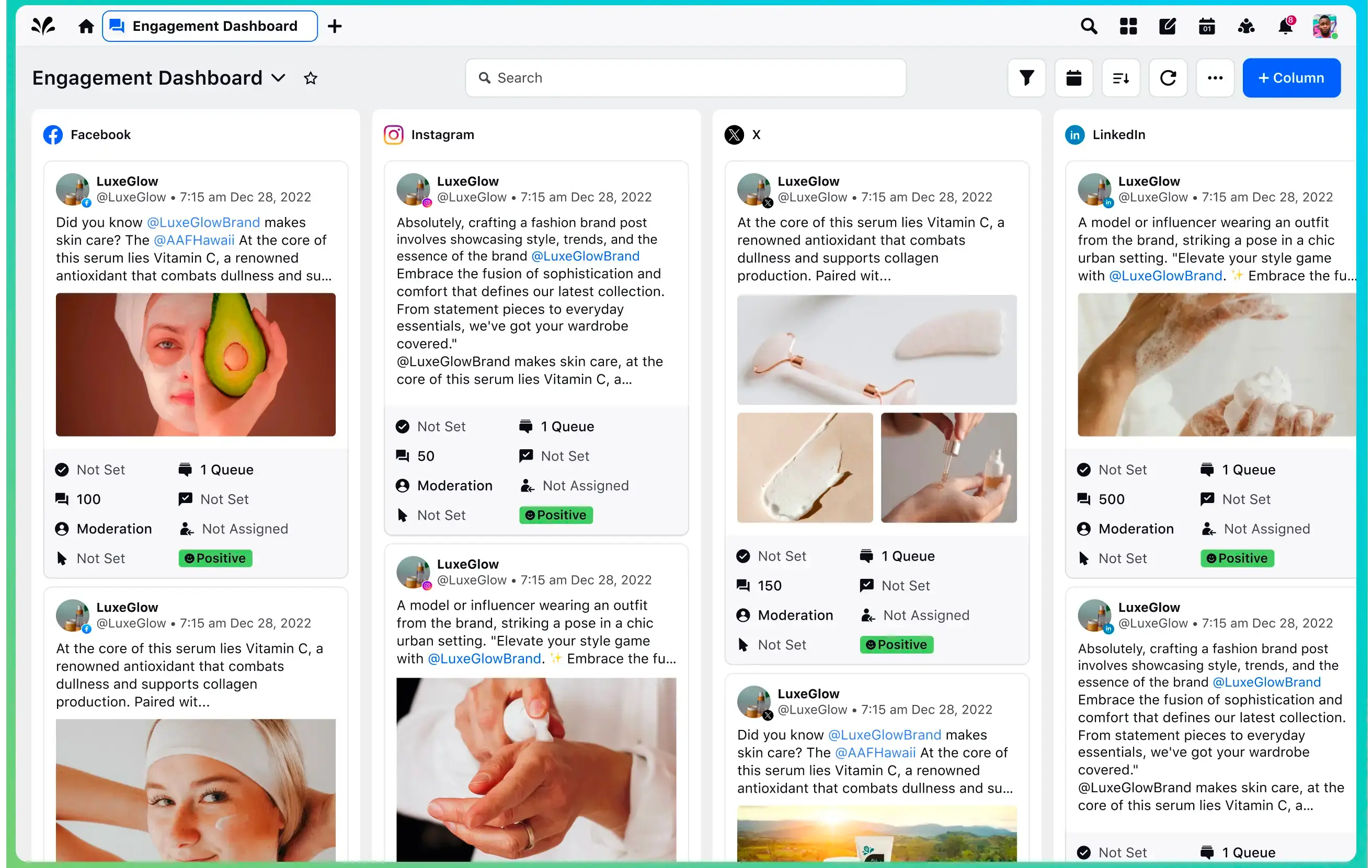The undisputed leader in social media management
For over a decade, the world’s largest enterprises have trusted Sprinklr Social for its in-depth listening, unmatched channel coverage, enterprise-grade configurability and industry-defining AI.

How to develop a memorable tone of voice for your social media
With brands trying to one-up each other online, a winning social media tone of voice can make all the difference.
Dwight Schrute, the fictional character from the American sitcom “The Office,” once famously exclaimed, "Identity theft is not a joke, Jim!" Well, neither is losing your brand's identity amidst a sea of forgettable content.
Now, like never before, consumers desire to establish an emotional bond with the brands they support or engage with. They seek to consume content that resonates with them — not merely addresses them.
Here’s to finding your voice in a crowded room (read: social media), where everyone speaks but nobody is truly heard. 🥂
What is social media tone of voice?
Social media tone of voice refers to a brand's unique expression, style and personality when communicating on social media platforms.
It covers the language, attitude and emotional undertones used in social media posts, comments, captions and interactions. The tone of voice can vary depending on the brand's values, target audience and objectives.
It's similar to Michael Scott's distinctive approach to management — occasionally cringe-worthy, frequently endearing, yet unquestionably unforgettable. The character from “The Office” is known for his inappropriate and eye-rolling behavior, as well as his frequent attempts at being funny and likable.
Much like how Michael's antics leave a long-lasting impression on his employees, your brand's tone of voice should leave a lasting impact that resonates within the hearts and minds of your audience. Why though? How does it matter?
Why tone of voice matters on social media
Picture this: your target audience is bombarded with a ceaseless stream of mundane and uninspiring content. In this sea of mediocrity, your brand has a choice — fade into oblivion or rise above the rest with a distinct tone of voice.
As Jim Halpert from “The Office” once wisely remarked, "Whenever I'm about to do something, I think, 'Would an idiot do that?' And if they would, I do not do that thing."
If you develop a distinctive and interesting communication style, you can prevent people from seeing you as just another unremarkable presence on social media. You'll be able to grab their interest and make them pay attention to what you have to say.
Difference between social media tone of voice and brand voice
One can say that the tone of voice is a subset of a brand’s voice.
While the concept of brand voice sets the stage, the tone of voice steals the show. Think about it in an office setting. The tone of voice is like the communication style used in different meetings — friendly, formal or humorous.
On the other hand, brand voice is the overall personality of the company that stays consistent across all meetings, reflecting its values, identity and how it interacts with others.
Your brand voice includes the core values and overall identity, while your tone of voice adds the spice that keeps your audience coming back for more.
Aspect | Tone of voice | Brand voice |
Definition | The manner of expression | The overall personality of a brand |
Purpose | Sets the emotional tone | Represents the brand's identity and values |
Flexibility | May vary across content formats and platforms | Remains consistent across all brand touchpoints |
Application | Applied to specific communications | Applied to all brand messaging and interactions |
Emphasis | Focuses on individual instances | Focuses on long-term brand perception |
Examples | Friendly, formal, humorous | Innovative, authoritative, customer-centric |
Adaptability | Adapts to context and audience | Maintains consistency regardless of audience |
Alignment | Reflects specific content goals | Reflects brand positioning and differentiation |
Importance | Influences immediate reactions | Influences overall brand perception |
Evolution | Can evolve over time | Evolves with brand strategy and market changes |
How to determine the right tone of voice for social media?
Developing an effective tone of voice for your social media presence requires a strategic approach.
Here are four easy steps to developing one:
Step 1: Understand your audience
Just as in an office, where you get to know your coworkers' personalities, preferences and working patterns, gaining deep insights into your target audience via a social listening tool is like understanding the dynamics of your office environment. It allows you to navigate social interactions and adapt your tone of voice accordingly.
Finding answers to the following will be helpful:
- Who is your target audience? Demographics, age range, gender, location, occupation, education level and other relevant details help you tailor your communication to resonate with them effectively.
- What are their needs and pain points? Knowing the challenges, problems or desires that your audience may have will help you position your product, service or message as a solution or opportunity that addresses their specific concerns.
- Where do they spend their time online? This helps you choose the right social media channels to effectively reach and engage with them.
Step 2: Define your brand persona
Think of your brand persona as a colleague with a distinct personality and values. In the same manner that each coworker contributes their unique qualities to the overall office culture, clearly defining your brand persona establishes the foundation for your tone of voice and sets the foundation for your social media presence. Here’s a small exercise to get you started:
- What makes your brand different from your competitors?
- How would your brand persona speak and communicate? (e.g., formal, casual, witty)
- How would your brand persona engage with your audience? (e.g., friendly, authoritative, empathetic)
Pro-Tip: Use social media sentiment analysis to gauge the perception and sentiment of your target audience. By analyzing social media sentiment, you can identify areas of improvement, address customer concerns and shape your brand persona to better resonate with their audience.
Step 3: Research competitors
In an office, you often observe and learn from your colleagues. Similarly, analyzing the tone of voice used by your competitors via competitive benchmarking is like studying how your coworkers interact. By identifying gaps and opportunities, you can differentiate your brand and create a unique voice that stands out.
Check out the following:
- Are they responsive to comments, messages and mentions?
- Do they initiate conversations and encourage participation?
- What content formats and channels do they prioritize?
Step 4: Test and iterate
Testing different tones of voice with your audience is more or less the same as experimenting with various approaches to workplace communication.
Just like how you would pay attention to the engagement and feedback received from your coworkers to find the most effective communication style at the office, analyzing the audience's response, feedback and sentiment via an audience intelligence platfrom helps you refine and iterate your tone of voice until you find the winning formula that resonates best with your audience.
Also Read: How to create a social media marketing strategy from scratch
3 real-life examples of effective tone of voice on social media
I hear you loud and clear. It's natural to want to know about real-life collaborations that have created a pandemonium in social media. And guess what? Your wait is over.
Wendy's with its unmissable humorous tone
Source: Bored Panda
Wendy's is not afraid to roast people on X, formerly Twitter. In fact, it’s completely unhinged and hilarious. This tweet, for example, is a response to a customer who asked what to do if Wendy's isn’t at their location. The company's response was simply, “Move.”
The fast-food chain stepped up its social media game in 2017. And boy, the numbers speak for themselves. The chain round out the top five most popular fast-food chains and its total sales reached $11.1 billion.
But its power extends far beyond its financial prowess. With an awe-inspiring army of 3.8 million followers on X, formerly Twitter, Wendy's has conquered social media with unparalleled might.
Its humorous and playful persona helped Wendy’s snag the No. 1 spot on Fast Company’s 2019 Most Innovative Companies list in the Social Media category.
Netflix’s conversational and pop-culture-savvy tone
Netflix has got this awesome conversational vibe, always staying up-to-date with pop culture. It sprinkles memes, trending references and heaps of humor into its posts to connect with its followers. It's like joining a big ol' community of binge-watchers and sharing epic experiences together. Such a cool way to keep everyone hooked, don't you think?
Source: Twitter
Netflix benefits from its unique social media tone of voice. Using humor, relatability and pop culture references, it humanizes the brand, boost engagement and create memorable marketing campaigns.
Also, its witty approach drives viral content, increases user-generated content and maintains a positive brand image while staying relevant and connected with its audience.
Patagonia’s environmental and social responsibility-driven tone of voice
Patagonia is an absolute champion regarding environmental and social responsibility. Its social media posts are all about saving the planet and promoting sustainability. It knows how to strike a chord with its audience of eco-warriors, making the brand feel like a superhero fighting for a better world.
Source: Twitter
Patagonia's environmental and social responsibility-driven tone of voice is doing wonders for them.
First, it's creating stronger brand loyalty, because customers love supporting a company that aligns with their values. Plus, it’s attracting conscious consumers who want to make ethical choices. This sets it apart in the market, giving it a real edge.
And you know what's cooler? All its positive actions are getting the brand some great PR. Even its employees are more engaged because they feel proud to work for a company that makes a positive impact.
Don't forget, these examples are just a starting point. Your brand's tone of voice should be true to who you are and what your audience cares about. It's all about finding your own unique style that aligns with your brand's identity and values. So go ahead and embrace it in your own remarkable way.
Signing off
Nailing your social media tone of voice is like finding the perfect beat to groove to — it makes your online presence effortlessly cool and enjoyable. So, here's the deal: be yourself, be relatable and keep it real.

